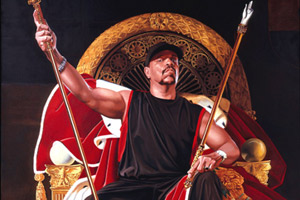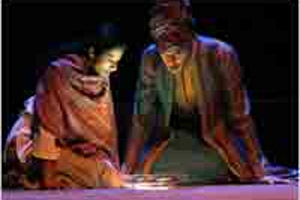Focus on America
Hip-Hop Exerts Influence on Contemporary Portraiture

Hip-hop always has been a potent vehicle for creative expression, but its role in contemporary portraiture has received little attention -- until now.
A new exhibition at the Smithsonian Institution’s National Portrait Gallery in Washington -- RECOGNIZE! Hip Hop and Contemporary Portraiture -- reveals how artists working in a variety of media create portraits filtered through the prism of hip-hop culture.
Hip-hop emerged as both a cultural movement and a genre of music in New York City during the 1970s. Developed primarily by African Americans, it is now embraced by youth culture on nearly every continent.
Frank H. Goodyear III, one of the three curators of RECOGNIZE!, concedes that hip-hop’s image has suffered because the lyrics to so-called “gangsta” rap songs widely are criticized for promoting violence and misogyny. Yet hip-hop often is misunderstood by people “whose only contact with the genre is through the media’s portrayal of its excesses,” he said in a recent interview. “This exhibition is an attempt to appreciate anew how creative, beautiful, uplifting and inclusive it can be.”
The National Portrait Gallery “is not trying to provide a comprehensive history of hip-hop culture, or even a snapshot of the overall movement,” Goodyear added. RECOGNIZE! is “an artist-centered exhibition. It’s a celebration of hip-hop, a way to better understand and engage with hip-hop, and an examination of issues that are central to hip-hop artists and their audience.”
RECOGNIZE! is the third exhibition of the gallery’s “Portraiture Now” series, and it features the work of photographer David Scheinbaum, painter Kehinde Wiley, graffiti muralists Tim Conlon and Dave Hupp, poet Nikki Giovanni, multimedia artist Shinique Smith and filmmaker Jefferson Pinder.
Scheinbaum’s black-and-white photographs of hip-hop performers evoke famous images of great jazz musicians from the 1930s, 1940s, and 1950s. “When I saw David’s work, I recognized something different,” said Goodyear. “His approach demonstrated an extraordinary commitment” to hip-hop culture.
The photographs also convey a sense of music history, and Scheinbaum’s nuanced portraits of hip-hop performers -- including Jurassic 5, Mos Def, Public Enemy and Jean Grae -- make a case for the continuity of American popular music forms, from blues to jazz to rock to hip-hop.
In contrast, Wiley’s heroically scaled paintings of young African-American men have an explosive quality not unlike the pulsating beat of hip-hop music. Wiley has stated that the history of portraiture offers few representations of black men, so he seeks to counter that absence.
HOMAGE AND REINVENTION
Hip-hop artist Jean Grae, photographed by David Scheinbaum (Gelatin silver print, 2002; © David Scheinbaum)
Hip-hop artist Jean Grae, photographed by David Scheinbaum (Gelatin silver print, 2002; © David Scheinbaum) He pays homage to the traditions of Western art, even as he questions many of the assumptions implicit in those traditions. Wiley is known for appropriating the compositions of Old Master paintings and substituting young black men for the figures in the originals. He adds sly art-historical references, such as baroque ornamentation in the background, or a family crest that recalls the aristocracy of the Renaissance era -- except that, on closer inspection, the crest reveals such emblems as a boombox and a pair of boxing gloves.
When the curators at the National Portrait Gallery began their survey of hip-hop and the contemporary art world, “we discovered that Kehinde Wiley had been commissioned to paint portraits of hip-hop stars for the 2005 Hip Hop Honors Show” airing on the VH1 television network, said co-curator Brandon Brame Fortune. Accordingly, RECOGNIZE! features a number of those commissioned portraits, including Ice T posed in the manner of Napoleon as painted by Jean Auguste Dominique Ingres in 1806, and LL Cool J reinventing the familiar pose of magnate John D. Rockefeller Sr. from the 1917 portrait by John Singer Sargent.
Hip-hop icons, said Fortune, “gain even more authority when they’re pictured as historical figures.”
Washington-based graffiti muralists Conlon and Hupp, who work together on panels that feature a distinctive lettering technique and a saturated color palette, contributed four pieces to the exhibition. The RECOGNIZE! curators decided to showcase the duo’s artwork because “we liked the idea of giving a Washington flavor to the show,” said Jobyl A. Boone, another co-curator. “They were a good fit for us. They’ve had some corporate commissions and they’re very accomplished.”
Boone cited one mural, in particular, for its strong hip-hop symbolism. Titled “CON,” it displays two stylized kings from a deck of cards. One king wields a can of spray paint, like a graffiti artist, while the other grasps a microphone, ready to start rapping. “In DJ circles, when you’ve reached the apex of your profession, you’re called a king,” Boone said.
POETRY AND IMAGE
Giovanni, an acclaimed poet, activist and educator who long has championed the hip-hop movement, was asked to write a new poem for the exhibition. The result, titled “It’s Not a Just Situation: Though We Just Can’t Keep Crying About It,” exhorts people to create art in the face of personal setbacks. Visitors can read the poem, which is stenciled on a wall, and also hear it spoken by Giovanni through a recording she made for the exhibition.
On two nearby walls is Smith’s multimedia installation, “No Thief to Blame.”
“We invited Shinique Smith to the Portrait Gallery to create a visual response to Nikki’s poem,” said Goodyear. “She produced an altar-like installation with approximately a dozen images of fallen hip-hop stars,” such as Tupac Shakur, Biggie Smalls, Lisa “Left-Eye” Lopes and Aaliyah. “No Thief to Blame” has a graffiti-like aesthetic, with the added texture of its composite parts: fabric, found objects and collage.
RECOGNIZE! concludes with three short videos by Pinder, who describes his films as a form of sampling and mixing his own experience with that of others.
In Mule, Pinder is shown pulling a heavy object -- literally dragging the weight of his own struggles -- as he trudges down a street. Car Wash Meditations documents an ordinary cleansing ritual, at once mundane and mysterious. Invisible Man, powered by a hip-hop soundtrack, recalls the protagonist of Ralph Ellison’s novel of the same name.
Exhibition dates are February 8 through October 26, 2008.
Recently on Focus on America
No Presidential Nominees After Super Tuesday
 When parties in 24 states scheduled primaries and caucuses for February 5 -- the most races ever on a single day in a primary election season -- most political experts said the parties’ nominees would be certain by the end of the day. The experts were wrong: After a record number of Americans voted on Super Tuesday, there is still no presumptive presidential nominee for either party, and the final delegate count still is being tallied.
When parties in 24 states scheduled primaries and caucuses for February 5 -- the most races ever on a single day in a primary election season -- most political experts said the parties’ nominees would be certain by the end of the day. The experts were wrong: After a record number of Americans voted on Super Tuesday, there is still no presumptive presidential nominee for either party, and the final delegate count still is being tallied.
Super-Duper Tuesday
 In an attempt to expand their influence on nomination races, many states moved their primaries or caucuses to early in the year. On February 5, nicknamed "Super Tuesday" or "Super-Duper Tuesday," 24 states hold nominating contests.
In an attempt to expand their influence on nomination races, many states moved their primaries or caucuses to early in the year. On February 5, nicknamed "Super Tuesday" or "Super-Duper Tuesday," 24 states hold nominating contests.
Play About Persian Folk Tale Delights Young American Audiences
 The Shakespeare Theatre Company of Washington, a showcase for the work of arguably the greatest writer in Western literature, has staged a children's play based on a Persian folk tale.
The Shakespeare Theatre Company of Washington, a showcase for the work of arguably the greatest writer in Western literature, has staged a children's play based on a Persian folk tale.